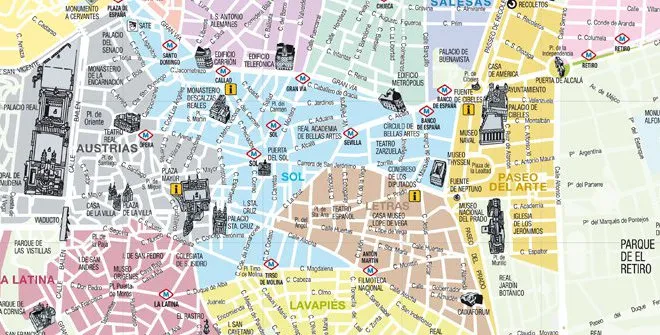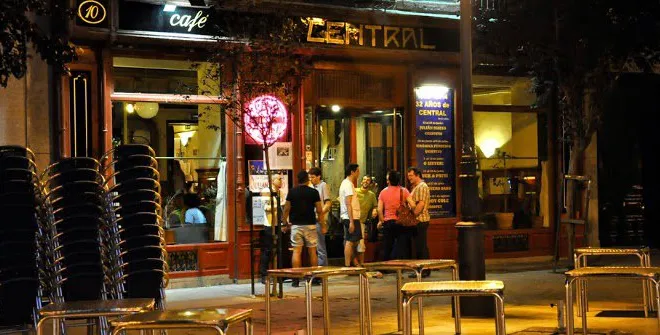Barrio de Las Letras
Explore the district where many giants of the Golden Age of Spanish literature had their homes
Barrio de las Letras (Literary Quarter) lies in the heart of Madrid, between such attractions as Sol-Gran Vía and Paseo del Arte (Art Walk). Its boundaries are Calle de la Cruz, Carrera de San Jerónimo, Paseo del Prado and Calle Atocha.
In the seventeenth century, the Golden Age of Spanish Literature, Cervantes, Lope de Vega, Quevedo, Tirso de Molina and Góngora, among other authors, had their homes here – hence the name. Some of the streets in this neighbourhood pay tribute to this and other brilliant chapters of Spanish history, culture and art.
Madrid’s Literary Quarter has always welcomed writers and literature lovers, who came to the corrales de comedias (open-air theatres) Del Príncipe, De la Pacheca and De la Cruz to watch theatrical performances, a popular pastime in those days. The Corral de Comedias del Príncipe, present-day Teatro Español, would stage the best comedies by playwrights from the Spanish Golden Age. The Teatro de la Cruz put on El sí de las niñas (The Maidens’ Consent) by Enlightenment author Leandro Fernández de Moratín, Rossini’s opera The Barber of Seville and Don Juan Tenorio by José Zorrilla.
The streets and sights in Barrio de las Letras reveal the district’s literary and cultural past.
CALLE HUERTAS
Running from Plaza del Ángel to Plaza de la Platería de Martínez, Calle Huertas is engraved with quotes from literary works penned by the best Spanish authors.
PLAZA DE SANTA ANA
The nerve centre of Barrio de las Letras, next to Teatro Español, this square features statues of Calderón de la Barca and Federico García Lorca. Statues alongside which you can take a good selfie.
Heir to the former Corral de Comedias del Príncipe, Teatro Español is one of the most important theatres in Madrid.
CALLE DE ÁLVAREZ GATO
Famous for being named in Luces de Bohemia (Lights of Bohemia), a theatre play by Ramón del Valle-Inclán, this street is popularly known as ‘Callejón del Gato’ (Cat’s Alley), featuring distorting concave and convex mirrors. This street is also one of the venues for the annual Max Star Night, which forms part of the La Noche de los Teatros (Theatre Night).
Built in 1850, Palacio de las Cortes is the epicentre of Spanish politics. It’s guarded at the entrance by two lions that were cast in bronze from the cannons used in the Hispano-Moroccan War (1860). Each year, there is an open doors day for visitors to commemorate Constitution Day, 6 December.
Madrid’s Artistic, Scientific and Literary Athenaeum was established in 1835 as a forum for the promotion of learning and the discussion of ideas.
Lope de Vega referred to the house he lived in for the last 25 years of his life as ‘my little house, my peace, my garden and my studio.’ Today the house is a museum dedicated to this great Spanish playwright.
CONVENT OF THE BAREFOOT TRINITARIANS
Known as the place where the tomb of Cervantes lies, this building dates back to 1673 and is the work of the architect, Marcos López.
The first and only Spanish lyrical theatre, offers an extensive programme with the best zarzuela works throughout the year.
Socio-cultural centre in which there is room for ancient, modern and contemporary art as well as multimedia; music and poetry festivals; debates on current issues; social conferences and family and educational workshops. Its beautiful vertical garden stands out with an amazing plant tapestry designed by Patrick Blanc.
Permanent space selling photographic work from PHotoESPAÑA, the International Festival of Photography and Visual Arts. Here, the work of a wide selection of national and international artists with different formats, techniques and styles dating back to the 20th and 21st centuries, can be acquired.
Miguel de Cervantes Saavedra lived at Number 2 of what is now known as Calle Cervantes, where the Lope de Vega house is also located. This house, on the corner of Calle del León and Cervantes, is where the famous novelist died.
In front of the Convent of the Trinitarian Nuns, is the house where Francisco de Quevedo, one of the most outstanding authors in Spanish literature, used to live. He is remembered with a large plaque on the façade of the building, which dates back to 1945.
Opened in 1916, its façade is one of the most unique of Madrid’s theatres, with Mauméjean stained glass and Talavera mosaics. It has capacity for more than 600 spectators and hosts major theatre shows.
This theatre has been the headquarters of the Radio Televisión Española Orchestra since 1988. Numerous theatre companies, magazines, shows and concerts have appeared on its stage. Its structure and the quality of its materials give it excellent acoustic quality.
Barrio de las Letras is ideal for a bit of retail therapy. Its narrow streets, many of them pedestrian only and most of them with restricted vehicle access, invite shoppers to a leisurely walk.
The commercial activity in the Las Letras Quarter has a marked artistic touch, as can only be the case given its illustrious residents throughout its history. We can find the great works by these Golden Age writers in the many bookshops that fill its streets. In them, you can find old and modern books, because this area is a journey through the most traditional without losing sight of the new trends; Kalandraka, for example and also Crazy Mary. Another hallmark of this area are its art galleries, many of which, such as La Fábrica, have avant-garde proposals.
Other shops that you will come across on a stroll around the Literary Quarter are establishments devoted to decoration and to antiques, such as Modernario. You can also visit independent boutiques such as the custom shoe shop Franjul.
Another market to bear in mind is the Ranas Market (Mercado de las Ranas) which is held on the first Saturday of each month. Traders in the area bring their products out onto the streets, decorate their shop windows and offer special promotions, whilst there are concerts and street theatre performances to liven up the atmosphere.
The traditional represented by authentic taverns, such as Los Gatos, where you can savour some of the most popular recipes of the cuisine from the Flavours of Madrid, such as patatas bravas (spicy potatoes) or the calamari baguette. La Platería is one of the best-known tapas bars in the neighbourhood and has a terrace that looks out over El Paseo del Prado and the Prado Museum. Casa González is a delicatessen shop with a small bar area where you can enjoy a class of wine or an aperitif, as well as breakfast and lunch.
The modern counterpoint comes with the numerous gastro-bars that have opened here in recent years, such as Tándem, in which these and other dishes are recreated with an avant-garde touch. In Calle Santa María, you can find Taberna La Elisa which offers a combination of tradition and renovation, haute-cuisine and traditional cuisine, where each dish is lovingly prepared.
Going out for tapas, you can find numerous haunts in the Las Letras quarter. After a long day of shopping, theatre or museums, the best thing is to regain your strength with this typical Spanish way of eating. There are a lot of good places to choose from depending on each person’s personal preferences. The Plaza de Santa Ana and its terraces, such as that of Ana La Santa or that of the Hotel Me Madrid Victoria Radio Me restaurant, are one of the most recommendable spots, but strolling down any of its narrow and quaint side streets, it is easy to find a place to satisfy your appetite.
In addition to numerous tapas bars, it is possible to find other restaurants to savour a less spontaneous and more relaxed meal, such as Triciclo or Gofio. There is no lack of cafeterias where you can accompany a cup of coffee with a good read or a light debate.
It is worth mentioning that the Literary Quarter is home to the haute cuisine Japanese restaurant, Yugo The Bunker, led by chef Julián Mármol, who has been awarded a Michelin star. With an exclusive decor, the restaurant offers two tasting menus with the finest market produce. The Canarian cuisine restaurant, Gofio by Cicero Canary run by the chef from Tenerife, Safe Cruz, which was awarded a Michelin Star in the 2020 edition, can also be found here.
Those with a sweet tooth can visit Sufu Cake, a pastry and cake shop with an international Japanese twist, specialising in fluffy soufflé pancakes.
Find out more about the flavours of the Madrid neighbourhood:
If during the day Barrio de las Letras is dominated by those who are interested in culture, shops and nice places to eat out, when the sun goes down it attracts thousands of locals and out-of-towners ready for nightlife action. The corner of Calle Príncipe and Calle Huertas, with Plaza de Santa Ana in between, is packed with bars and clubs.
Nightlife in this area is marked by the diversity of styles, ages and leisure habits, so everyone can find their ideal place. There are pubs and discos with a young atmosphere. Some of these discos even open all night for those who want to enjoy themselves until dawn. Other establishments, such as Salmón Gurú, where you can have a relaxed drink whilst discussing the theatre play you have just seen, is another of the leisure hotspots in this area; and even the traditional-style bar La Venencia.
It is also possible to accompany a drink with a live music performance of different styles, ranging from jazz to flamenco. Among such establishments, we can highlight La Fídula, Café Central or Cardamomo. Finally, the exclusive terraces to be found in some of the hotels of the area must also be mentioned, where you can enjoy delicious cocktails and privileged views.
The famous Argentinean barman, Diego Cabrera, has the Viva Madrid tavern close to the Plaza de Santa Ana. It is a space where cocktail and tavern concepts are combined with a menu that offers a wide selection of classic cocktails. Santos y Desamparados also forms part of the cocktail revolution in Madrid’s nightlife, along with the restaurant-cocktail lounge, Decadente, the perfect option to kick off the evening, and the Lovo Bar, Belisa, La Santoría, Caracortada and Calle 365 Callejón Secreto cocktail bars.












